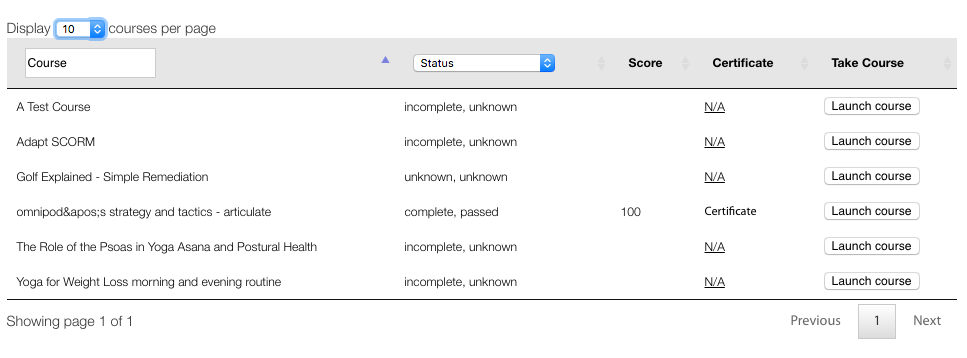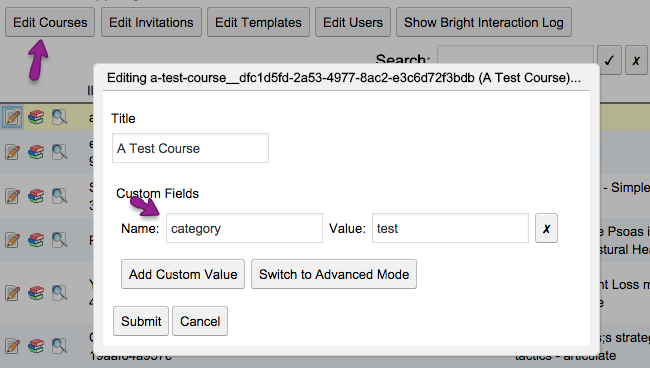template: bright-course-table
The bright-course-list template is a standard Bright course lister. It can be used to represent a flexible list of courses on the page, in a standard format.
Some of the things you can do with the course table is:
- control which courses are represented
- control the appearance and criteria of a certificate link.
- control whether the table is interactively searchable and sortable.
- you can also enable or disable self-registration.
Got more ideas for it? Tell us!
Need even more functionality? Click here on how to capture template code and start building your own Bright courselist template.
bright-course-table
[bright template="bright-course-table" type="courselist"/]
Setting Filter Criteria
There are two filtering models, by explicit field value [like the value of a category or Bright custom field], or by a custom JavaScript function
Filtering by a Course Metadata Field
You can add custom metadata for a course with the Embedded Bright Administrative Console.
In this example, our courses have a Bright custom field called category, and we would like to show those courses with a value of 'test':
[bright template="bright-course-table" type="courselist" filter_field="category" filter_namespace="custom" filter_value="test"/]
'custom' is the namespace to use for custom fields created via the Embedded Bright Administrative Console. For now, a single namespace level is allowed. For multiple level variables [like custom.my_document.another_value], use a filter function.
Filtering by a Javascript Function
MyBrightExtensions = {
filter_courses: function(courses) {
return [courses[2]];
},
}
Then:
[bright template="bright-course-table" type="courselist" self_register="true" launch_button_text="Launch" certificate_link="/certificate" filter_namespace="MyBrightExtensions" filter_function="filter_courses"/]
Changing Sort Criteria
By default, the bright-course-table will sort by the course title. There are two ways to modify this
Sort criteria by context field.
Example, sort by score:
[bright template="bright-course-table" type="courselist" sort_field="score"/]
Example, sort by SCORM metadata description:
[bright template="bright-course-table" type="courselist" sort_namespace="metadata" sort_field="description"/]
Example, sort in custom function
Some javascript somewhere:
MyBrightExtensions = {
sortCourses: function(courses) {
// sort the courses here by whatever method your prefer.
return courses;
}
}
Now:
[bright template="bright-course-table" type="courselist" sort_namespace="MyBrightExtensions" sort_function="sortCourses"/]
Reversing the sort order
Use [bright template="bright-course-table" .... reverse="true"/]
to reverse the sorted order.
Allowing Self Registration
This template defaults to requiring pre-registration. Just set self-registration=true to allow user's to self register:
[bright type="courselist" template="bright-course-table" self_register="true"/]
Certificates
By default:
- the certificate link is enabled. Use 'no_certificate="true"' to disabled it
- the certificate link is '/certificate' ; use the certificate_link attribute to override this.
-
the certificate criteria is the SCORM variable 'success' is set to passed. This can be changed [see below].
[bright type="courselist" template="bright-course-table" certificate_link="/certificate"/]
For more on the default Bright certificate template, see here. Usually, you will create a page called 'Certificate' and add the
certificate shortcode to that page like:
[bright type="course" template="certificate"/]
Note if you set certificate criteria, you'll want the same certificate criteria in that shortcode.
Suppress Certificate Link
[bright type="courselist" template="bright-course-table" no_certificate="true"/]
Change Certificate Link
[bright type="courselist" template="bright-course-table" certificate_link="/my-certificate"/]
Controlling Certificate Criteria
You have fine-grained control over by what criteria a certificate can be offered, and what message to show the user if they've failed to meet their criteria:
[bright type="courselist" template="bright-course-table" certificate_link="/certificate" criteria_field="score" criteria_value="80" criteria_operator=">" criteria_comment="You must pass with at least a score of 80 to access your certificate"]
In the above, we use the following attributes:
- criteria_field - describes the field in the user's registration to use as the certificate criteria. Defaults to 'success'.
- criteria_value - the value to compare with the {{criteria_field} above. Defaults to 'passed'.
- criteria_operator - the operator to use in comparison. The default is '=='.
- criteria_comment - If the user fails the criteria, they can mouse over the 'N/A' that is displayed in lieu of the certificate link to receive this message. Defaults to 'You must pass and/or complete the course to receive your certificate.'
Changing the Launch Button Text
Use the launch_button_text embedder attribute:
[bright type="courselist" template="bright-course-table" launch_button_text="Launch Quiz"]
Changing the not-started message
[bright template="bright-course-table" type="courselist" not_started_message="begin now"/]
Suppress searching and sorting [Datatables]
Disabling datatables on your course table is a snap, just add:
[bright template="bright-course-table" type="courselist" self_register="true" launch_button_text="Launch" certificate_link="/certificate" no_datatables="true"/]


